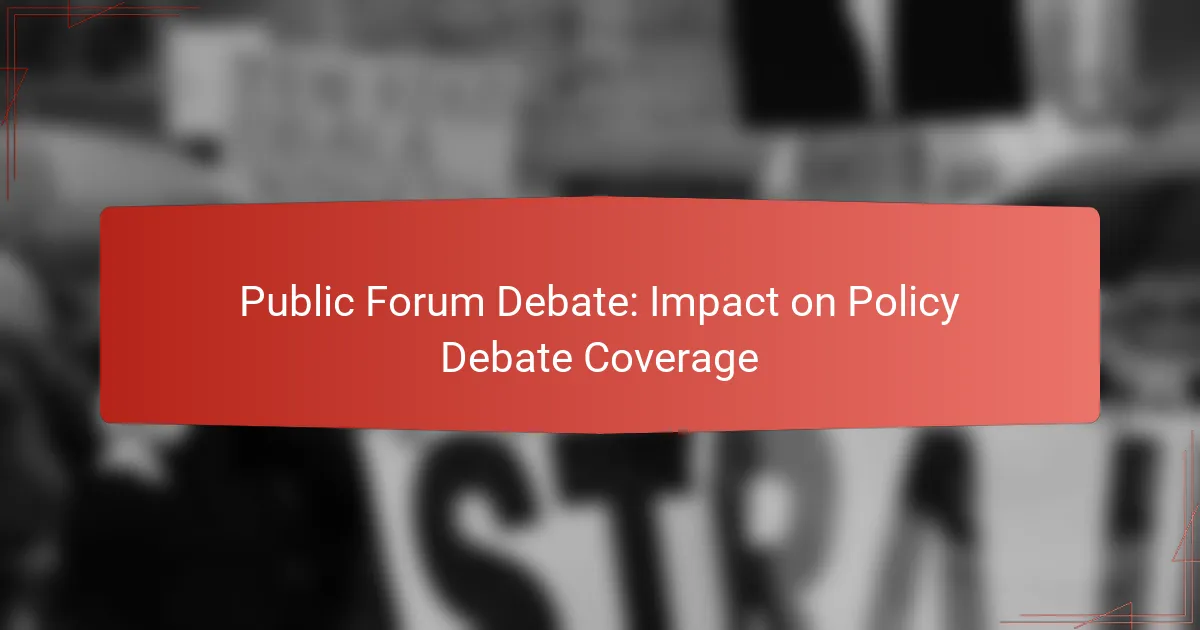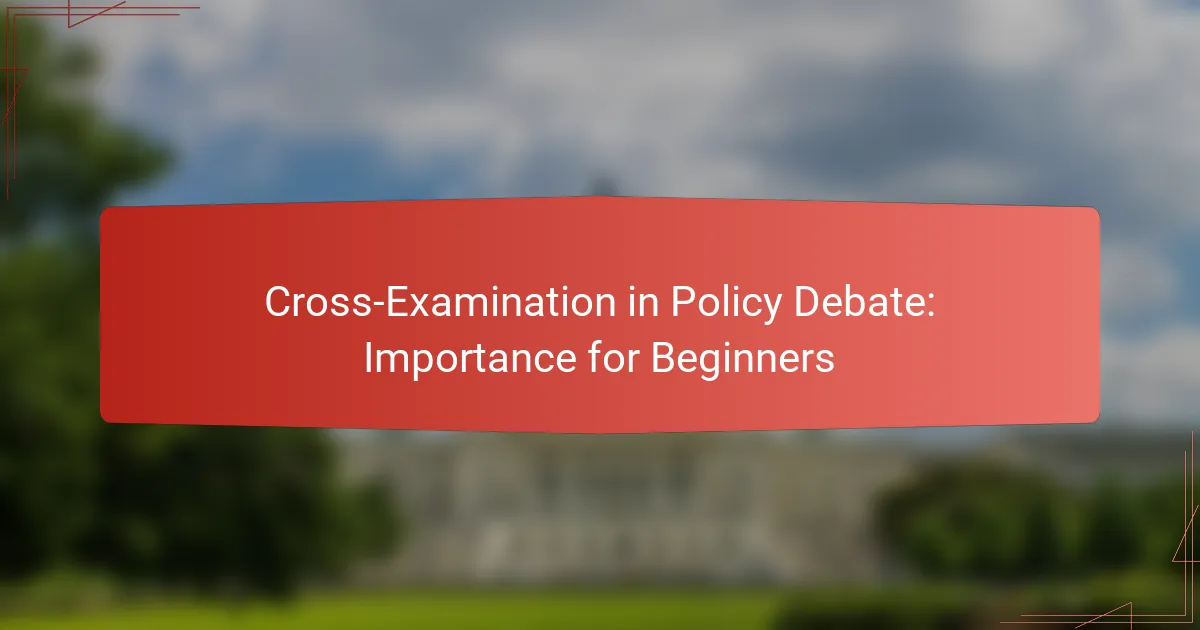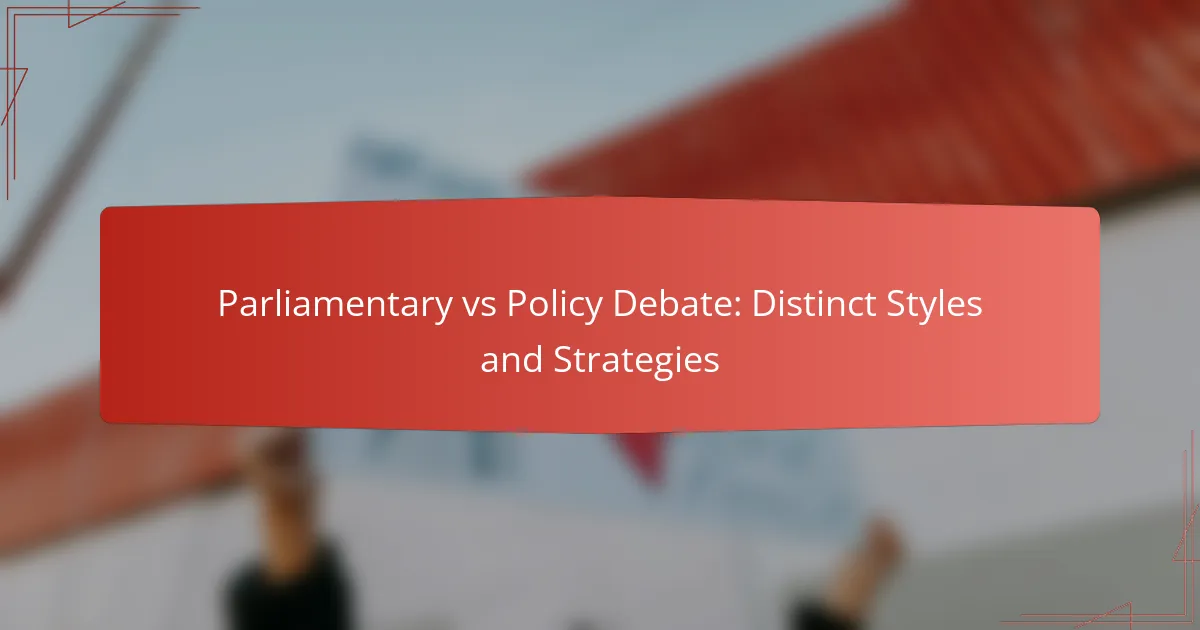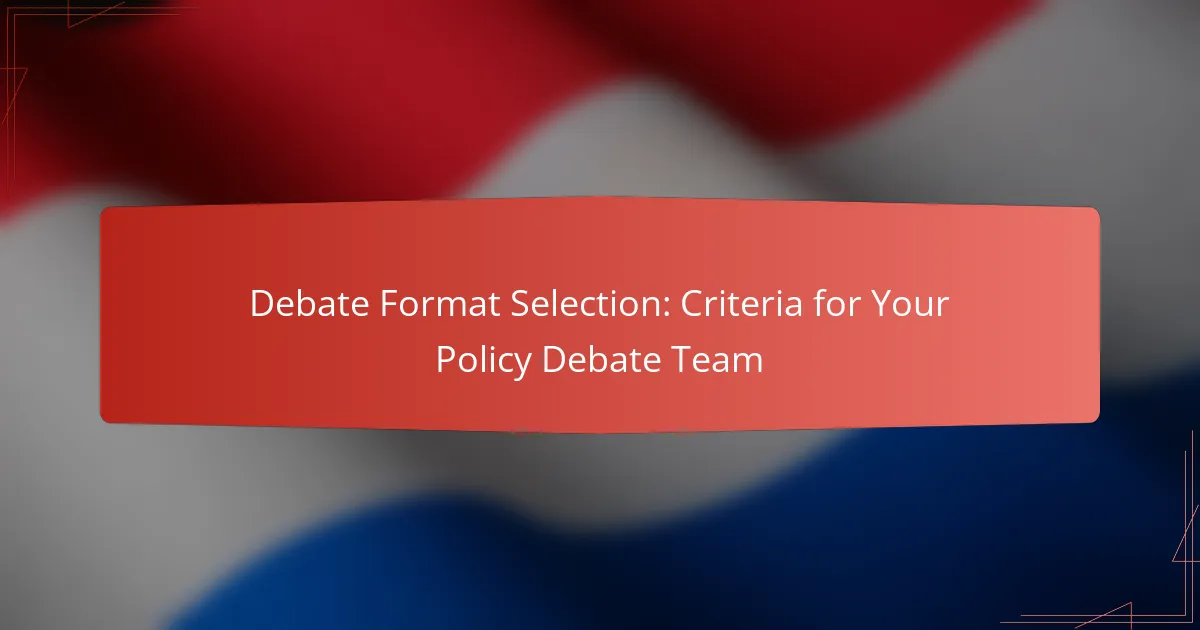Public Forum Debate plays a crucial role in shaping policy debate coverage in the United States by fostering a more inclusive and accessible format. This approach not only encourages broader participation but also influences how policy debates are framed and understood by the general public, making them more relatable and engaging.
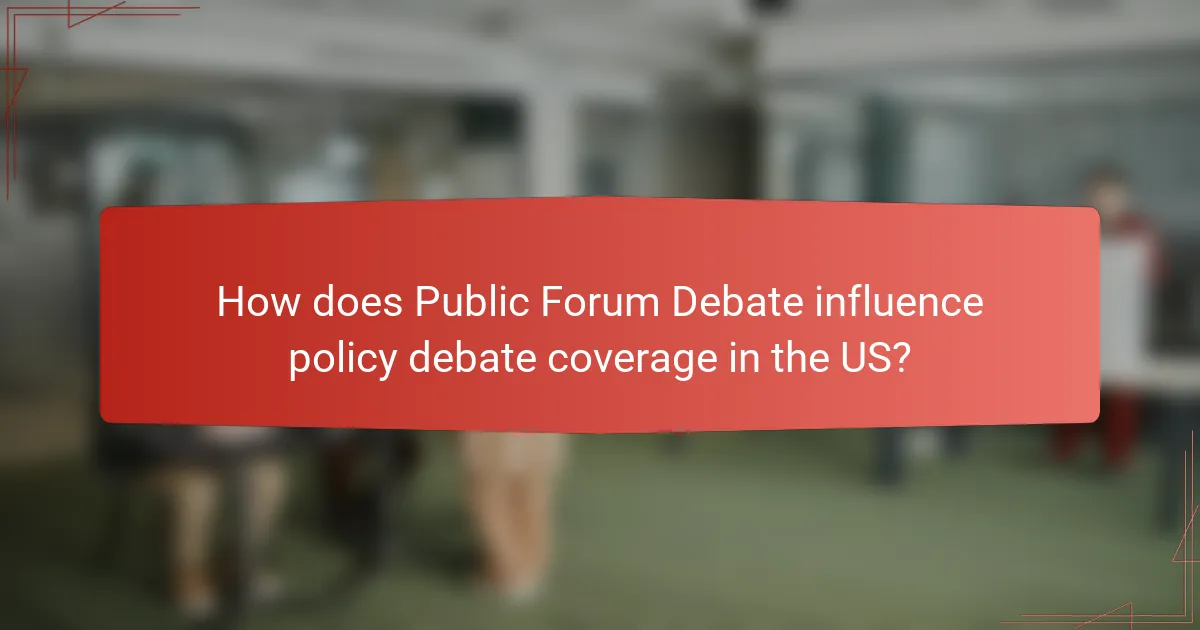
How does Public Forum Debate influence policy debate coverage in the US?
Public Forum Debate significantly impacts policy debate coverage in the US by promoting a more inclusive and accessible format that encourages participation from a wider range of voices. This influence is evident in how policy debates are framed and reported, making them more relatable to the general public.
Increased accessibility for diverse voices
Public Forum Debate is designed to be accessible, allowing participants from various backgrounds to engage in discussions on pressing issues. This format encourages diversity in viewpoints, which can lead to richer policy debate coverage that reflects a broader spectrum of opinions.
By simplifying complex topics and emphasizing clarity, Public Forum Debate attracts debaters who might not traditionally participate in more technical policy debates. This inclusivity helps ensure that the concerns of underrepresented groups are voiced and considered in policy discussions.
Enhanced engagement with current events
Public Forum Debate often focuses on contemporary issues, making it highly relevant to current events. This connection fosters a dynamic dialogue that keeps policy debates aligned with what is happening in society, ensuring that the coverage remains timely and engaging.
Debaters are encouraged to use recent news and developments as part of their arguments, which not only informs their positions but also helps the audience relate to the topics being debated. This engagement can lead to increased public interest and awareness of policy issues.
Broader audience reach through media
The format of Public Forum Debate lends itself well to various media platforms, enhancing its reach to a broader audience. Debates are often streamed online or covered by news outlets, allowing more people to access and engage with the content.
This media presence can amplify the voices of debaters and the issues they discuss, making policy debates more visible to the public. As a result, the coverage of these debates can influence public opinion and policy-making by highlighting key arguments and perspectives that resonate with a wider audience.
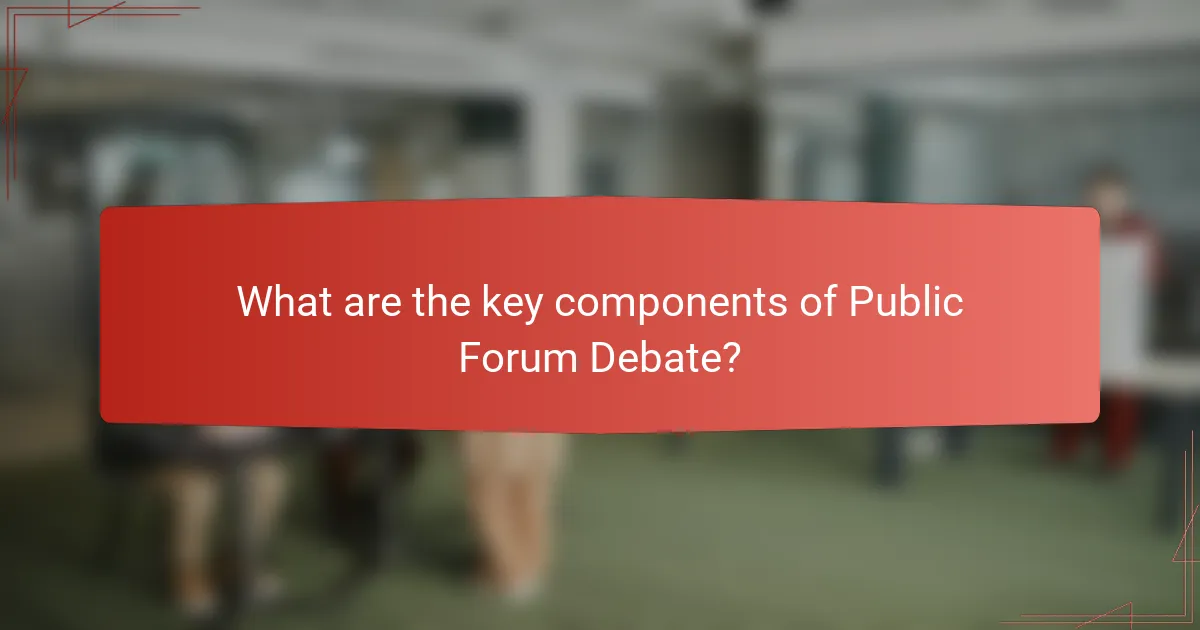
What are the key components of Public Forum Debate?
Public Forum Debate consists of several essential components that define its structure and execution. These include the format and structure of the debates, the role of cross-examination, and the criteria used for judging and scoring the debates.
Format and structure of debates
The format of Public Forum Debate typically involves two teams, each consisting of two members, who argue for or against a resolution. Debates are structured with alternating speeches, including constructive speeches, rebuttals, and summary speeches, followed by a final focus from each team.
Each debate lasts around 35 minutes, with specific time allocations for each speech and cross-examination period. This structure encourages clarity and direct engagement with the topic, allowing debaters to present their arguments effectively.
Role of cross-examination
Cross-examination is a critical component of Public Forum Debate, allowing debaters to ask questions of their opponents after their constructive speeches. This interaction helps clarify arguments, challenge assumptions, and expose weaknesses in the opposing team’s case.
During cross-examination, debaters should focus on strategic questioning that reveals gaps in logic or evidence. Effective cross-examination can significantly impact the overall debate by shifting the momentum in favor of the questioning team.
Judging criteria and scoring
Judging in Public Forum Debate is based on several criteria, including the clarity of arguments, the use of evidence, and the overall persuasiveness of the debaters. Judges typically look for how well each team presents their case and responds to questions during cross-examination.
Scoring often involves a combination of subjective evaluation and adherence to established guidelines, with judges considering factors such as argumentation quality, delivery, and teamwork. A clear understanding of these criteria can help debaters tailor their strategies to maximize their chances of success.
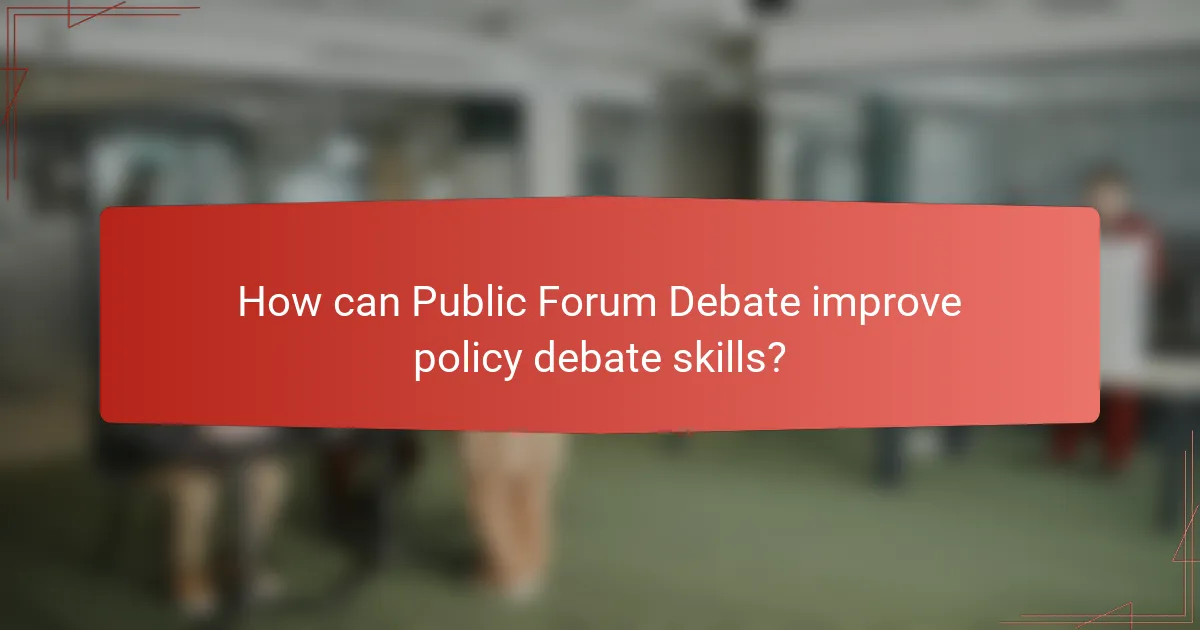
How can Public Forum Debate improve policy debate skills?
Public Forum Debate can significantly enhance policy debate skills by fostering a collaborative environment that emphasizes clarity and accessibility. Participants learn to articulate their arguments effectively, which translates well into the more complex structures of policy debate.
Development of critical thinking
Engaging in Public Forum Debate encourages participants to analyze issues from multiple perspectives, enhancing their critical thinking abilities. Debaters must evaluate evidence, assess the validity of arguments, and anticipate counterarguments, which are essential skills in policy debate.
To strengthen critical thinking, debaters should practice questioning assumptions and exploring the implications of their arguments. Regularly participating in debates on current events can help sharpen these skills, as they require quick thinking and adaptability.
Improved public speaking abilities
Public Forum Debate places a strong emphasis on effective communication, which directly benefits public speaking skills. Debaters learn to present their ideas clearly and persuasively, making them more confident speakers in various settings.
To improve public speaking, participants should focus on pacing, tone, and body language during their presentations. Practicing in front of peers and receiving constructive feedback can help refine these skills further.
Enhanced research and argumentation skills
Public Forum Debate requires extensive research to support arguments, which enhances overall research skills. Debaters learn to gather credible sources, synthesize information, and construct logical arguments, all of which are crucial in policy debate.
To maximize research effectiveness, debaters should develop a systematic approach to gathering information, such as using reliable databases and keeping track of sources. Creating outlines for arguments can also help organize thoughts and ensure comprehensive coverage of the topic.

What are the challenges faced in policy debate coverage?
Policy debate coverage faces several challenges that impact its effectiveness and reach. Key issues include media bias, audience comprehension, and resource constraints, which can hinder the accurate representation of debates and their implications.
Media bias and representation issues
Media bias can significantly distort the portrayal of policy debates, often favoring certain viewpoints over others. This bias may lead to selective reporting, where only specific arguments are highlighted, potentially misrepresenting the overall debate landscape.
Additionally, underrepresentation of diverse perspectives can skew public understanding. For instance, if coverage predominantly features elite voices, it may neglect grassroots opinions that are equally important in shaping policy discussions.
Lack of understanding among audiences
Many audiences struggle to grasp the complexities of policy debates, which can lead to disengagement. The technical language and intricate arguments often used in debates may alienate viewers who lack a background in the subject matter.
To improve comprehension, media outlets should strive to simplify explanations and provide context. Utilizing visuals, summaries, and relatable examples can help bridge the gap between complex policy issues and audience understanding.
Resource limitations for coverage
Limited resources can severely restrict the depth and breadth of policy debate coverage. Many media organizations face budget constraints that prevent them from dedicating sufficient time and personnel to cover debates comprehensively.
Moreover, smaller outlets may lack access to expert commentators or analysts, which can diminish the quality of the coverage. Collaborating with educational institutions or think tanks could enhance reporting by providing valuable insights and expertise.
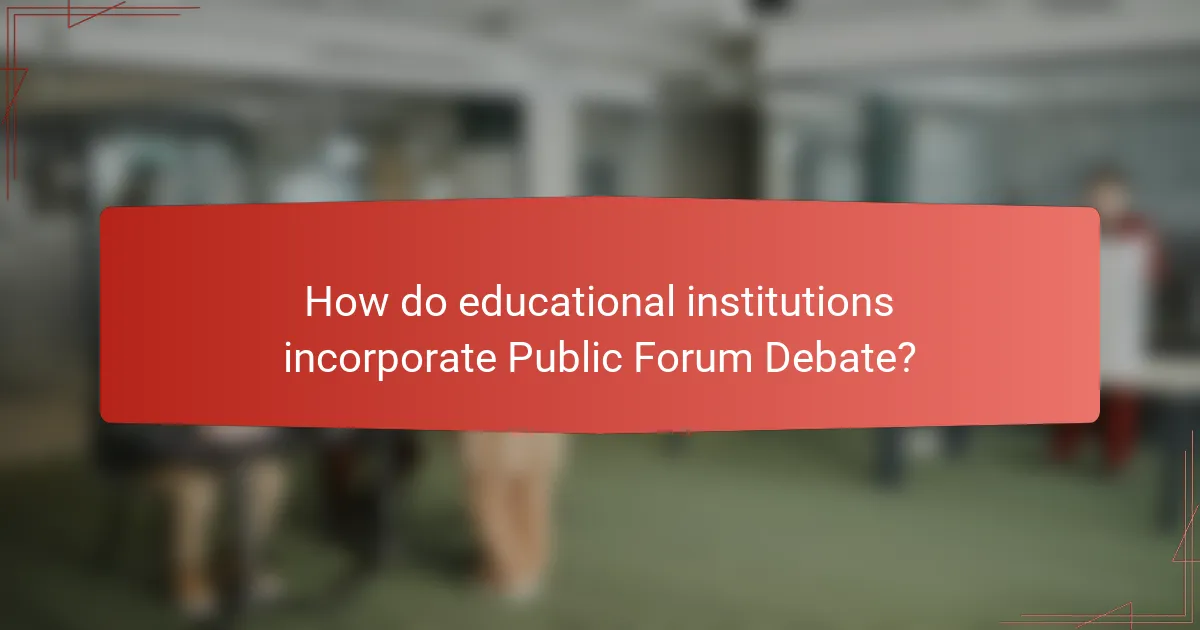
How do educational institutions incorporate Public Forum Debate?
Educational institutions integrate Public Forum Debate into their programs to enhance students’ critical thinking and public speaking skills. This incorporation often occurs through dedicated debate classes, extracurricular activities, and competitive events that engage students in current events and policy discussions.
Curriculum integration in high schools
High schools commonly include Public Forum Debate in their curriculum as part of speech or communication classes. These programs focus on teaching students how to construct arguments, engage in research, and develop effective speaking techniques. Some schools may offer specific debate teams that compete regionally or nationally, providing students with practical experience.
Incorporating Public Forum Debate into the curriculum can also foster collaboration among students, encouraging teamwork and peer feedback. Schools often align debate topics with current events, ensuring that students remain informed and engaged with real-world issues.
Support from debate organizations like the NSDA
Organizations such as the National Speech & Debate Association (NSDA) play a crucial role in supporting Public Forum Debate in educational settings. They provide resources, training, and guidelines that help schools establish and maintain debate programs. The NSDA also organizes tournaments and events that allow students to showcase their skills and gain recognition.
Through workshops and online resources, the NSDA equips educators with strategies to effectively teach Public Forum Debate. This support can be invaluable for schools that may lack experienced debate coaches or resources to develop their programs.
Partnerships with local media outlets
Many educational institutions form partnerships with local media outlets to enhance their Public Forum Debate programs. These collaborations can provide students with opportunities to engage with journalists, learn about media coverage, and understand the role of public discourse in shaping policy. Such partnerships may also involve hosting debates that are broadcasted or reported on, increasing community awareness and involvement.
By partnering with local media, schools can create a platform for students to present their arguments to a broader audience, fostering a sense of civic engagement. This exposure can also motivate students to refine their debating skills and understand the impact of their arguments in real-world contexts.
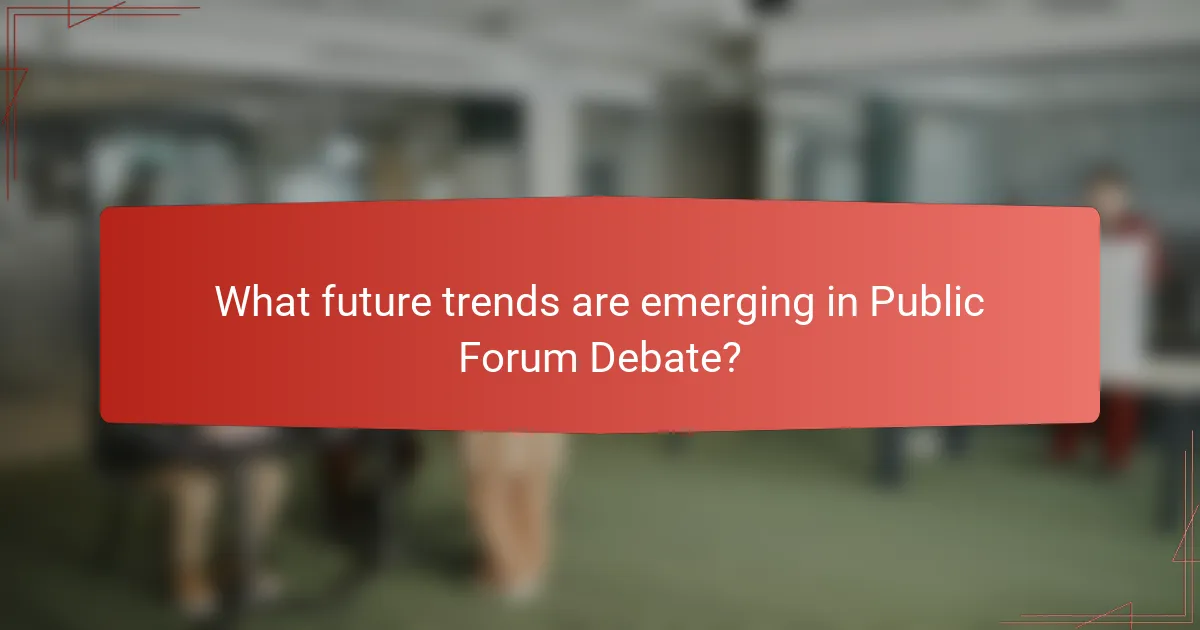
What future trends are emerging in Public Forum Debate?
Future trends in Public Forum Debate are increasingly shaped by technology, a focus on social justice issues, and the rise of online platforms. These elements are transforming how debates are conducted and the topics that are prioritized.
Increased use of technology in debates
The integration of technology in Public Forum Debate is becoming more prevalent, enhancing both the preparation and execution of debates. Tools such as digital research databases, presentation software, and online collaboration platforms allow debaters to access information quickly and present arguments more effectively.
Debaters should consider using apps that facilitate real-time feedback and analysis, which can improve performance. However, it’s crucial to ensure that reliance on technology does not overshadow critical thinking and argumentation skills.
Focus on social justice issues
Public Forum Debate is increasingly addressing social justice topics, reflecting broader societal concerns. Issues such as racial equality, climate change, and economic disparity are becoming central themes, encouraging debaters to engage with current events and ethical considerations.
Debaters should stay informed about these topics and develop nuanced arguments that consider multiple perspectives. Engaging with social justice issues not only enriches debates but also fosters a deeper understanding of the world around participants.
Growth of online debate platforms
The rise of online debate platforms is revolutionizing how Public Forum Debate is conducted, making it more accessible to a wider audience. These platforms allow participants from different regions to compete without geographical constraints, promoting diversity in viewpoints and experiences.
While online debates offer convenience, debaters must adapt to the unique dynamics of virtual communication, such as managing technical issues and maintaining engagement. Embracing these platforms can enhance debate skills and broaden participants’ networks.
